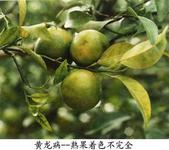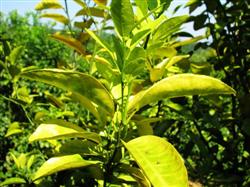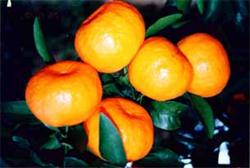Identification and Control of Citrus Huanglong Disease

1. The typical symptom of the diseased tree in the initial stage is the yellowing of leaves with 1-2 or more branches in the thick green crown. There are two types of symptoms in this yellowing branch, one is uniform yellowing of the whole leaf, and the other is a piece of yellow and green, which is called mottled type. The common characteristics of these two types of leaves are hardening and lack of luster. The old leaves in the lower part of the yellow shoot are still normal green. However, due to different periods of onset, the symptoms of diseased leaves are also slightly different. The new spring shoots of diseased trees could turn green normally, but as the spring shoots matured, the leaves gradually faded and turned yellow, and the number of yellow shoots was more. The leaves of the summer and autumn shoots of the diseased trees could not turn green normally and gradually changed from yellowish to yellow, and the number of diseased shoots was less than that of spring shoots. The leaves on the yellowing shoots of that year fell off one after another at the end of autumn, and all fell off before the spring buds germinated the following year. In the second year, the diseased shoots appeared early, short and weak, the diseased leaves were thin and narrow, the leaves were sclerotic, the main and lateral veins were green, and the rest of the mesophyll was yellowish or yellow, similar to the symptoms of zinc deficiency. At this time, the new shoots of other parts of the crown appeared yellowing or yellow-green symptoms one after another. With the further development of the disease, the yellowing diseased shoots increased day by day, the leaves fell off, coupled with root decay, the growth of diseased trees gradually weakened, the branches of early disease gradually withered, and then the diseased plants gradually withered. The diseased tree blossoms early, and its petals are short, small, thick and yellowish. Some stigmas are often curved and exposed, and flowers on the twigs often gather into clusters. This phenomenon is called "playing bouquets" by farmers. In the end, almost all of these flowers fall off, and only a few of them bear fruit. Diseased fruit, deformed, soft pericarp, dull, sour taste, uneven yellow and green when coloring, orange-red near the pedicel of some varieties, while the rest is still turquoise, called "red nose fruit". Whether it is a tree or a shoot, Huanglong disease begins at the top of the leaf and then spreads downward. And the leaves harden. Even after strengthening the management, the symptoms will not subside. Physiological diseases usually start at the lower part of the crown and then spread upward. The diseased leaves are soft and will not harden. After strengthening the management of water and fertilizer, the symptoms will gradually subside. If the symptoms of the leaves are mottled and the leaves are hard, it can be diagnosed as Huanglong diseased tree. Control measures Citrus Huanglong disease is a destructive disease, which spreads rapidly, and the existing citrus varieties are susceptible to the disease. therefore, comprehensive measures must be taken to control citrus Huanglong disease in order to achieve good results. 1. Strictly carry out quarantine, and strictly prohibit the transfer of seedlings and diseased materials (such as scions) from the disease area to the new area and disease-free area. In the disease area, seedlings with or may be diseased should be planted relatively centrally in a controlled area to prevent further spread. All newly opened orchards should be planted with disease-free seedlings. 2. Establishing disease-free nursery and cultivating disease-free seedlings are the key measures to control citrus Huanglong disease. It is necessary to cultivate disease-free seedlings without Huanglong disease and some dangerous diseases (such as canker, split skin disease, etc.). For new orchards in new areas and disease-free areas. 3. Dig out the diseased plant. In view of the fact that there is no effective way to treat citrus trees with Huanglong disease. And the diseased tree left in the field is a source of disease. Therefore, as soon as the tree is found to be Huanglong disease, digging it immediately is an important measure to prevent the spread of Huanglong disease. The practice is: every year in spring, summer and autumn, especially in autumn, carefully check plant by plant, find diseased plants or suspected diseased plants, dig up and burn them immediately. Before digging up diseased trees, 40% omethoate and 1000 times of omethoate should be sprayed on diseased trees and nearby plants to prevent citrus wood lice from spreading from diseased trees to the surrounding areas. New citrus orchards with an incidence of less than 10% and old citrus orchards with an incidence of less than 20% can be replanted with disease-free seedlings after digging out diseased plants. 4. Control citrus planthopper. Citrus planthopper is an insect that spreads Huanglong disease. Grow on the new buds and shoots of citrus. The shoot is controlled by controlling water and fertilizer, so that the new shoot is neat and consistent, and the shooting period is shortened. When the new shoot is drawn to 1-2 cm, spray insecticide 1-2 times. In winter, citrus planthoppers like to fly to Jiuli incense near the orchard to spend the winter. Spraying insecticide on Jiuli incense plays a certain role in reducing the number of wood lice. In addition, planting shelterbelts around the orchard can hinder the migration of wood lice. 5. Strengthening the management, especially the water and fertilizer management of the fruiting trees, keeping the trees strong and vigorous and improving the disease resistance, play an important role in reducing the occurrence of Huanglong disease and the loss caused by the disease. 6. Transform the ward into a new area. For some orchards where citrus Huanglong disease is very serious and has lost its economic value, the disease area should be rebuilt, that is, all the citrus trees in the whole orchard (including those that may have been infected but have not shown symptoms) should be excavated, and then replanted with disease-free seedlings. By doing a good job in pest prevention, digging up diseased trees in time and strengthening management, the disease area can be transformed into a disease-free new area.
- Prev

Symptom Identification and Prevention and Control techniques of Citrus Huanglong Disease
Citrus Huanglong disease is also known as "orange cancer". A bacterial disease caused by phloem, which is spread by grafted seedlings and an insect called citrus planthopper, does great harm to citrus. If allowed to spread, it will cause a fatal blow to the citrus industry. Great attention must be paid to it.
- Next

Management and cultivation techniques of citrus in late stage
Orange picked with new lipid membrane solution after soaking on orange storage period of green, green mold, anthracnose, stem rot, black rot, etc. have good control effect, at the same time can prevent water evaporation, prevent bacteria infection, frost insulation, does not affect the crop water absorption, ventilation and light transmission, protect crops from external diseases infection, prolong preservation...
Related
- Moge, come on! The staff of the peasant association in the producing area of cantaloupe were frightened when the crowd gathered.
- Causes and Solutions of low Fruit setting rate of Apple
- Symptoms and control measures of passion fruit virus disease
- Fruit growing lesson: how do apple orchards keep high yields?
- Can you build orchards in the mountains? What are the pros and cons?
- How to manage the coloring period of Crisson grape?
- This paper introduces the processing technology of two kinds of fig products.
- How much is a month for retired teachers in rural areas by 2020?
- How can strawberry planting increase sugar content? We should pay attention to management in many aspects.
- What are the cultivation techniques on how to improve the yield of golden fruit?

